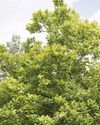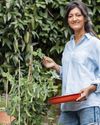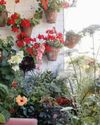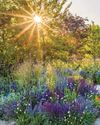
"Deck the halls with boughs of holly" ...and don't forget the Christmas tree. As if you could! Even the most restrained of Christmas decorators will indulge in a modest arboreal show in December, but which of the many types of tree will you choose and how can you keep it going until Twelfth Night? The answer is by choosing carefully and positioning it wisely and at the right time. Prince Albert is most frequently cited as the originator of the tradition, but despite his love of bringing spruce trees into Queen Victoria's palaces and castles at Christmas, the custom is thought to have started in 16th-century Germany when Martin Luther decorated a tree with candles to celebrate the birth of Christ. Well before this, pagans were keen on bringing indoors branches of evergreens in the darkest months of the year to remind themselves that all was not lost and that spring would return with its abundance of new life and green shoots. Here in Britain, though, it is fair to say that Prince Albert most certainly gave the custom a shot in the arm and increased its popularity.
Fashionably late
But don’t be too hasty in bringing yours in. If you want your tree to last, leave it for as long as possible - central heating and spruce and fir needles are not happy bedfellows and desiccation will be rapid if you choose to bring the tree indoors at the end of November.
Your Christmas tree will most likely have been cut a week or so before it makes its way to the sales outlet, be it garden centre or farm shop. Buy it and take it home as soon as you like to make sure you have one that has a good shape, but leave it outdoors for as long as you can to keep it fresh.
هذه القصة مأخوذة من طبعة December 2023 من BBC Gardeners World.
ابدأ النسخة التجريبية المجانية من Magzter GOLD لمدة 7 أيام للوصول إلى آلاف القصص المتميزة المنسقة وأكثر من 9,000 مجلة وصحيفة.
بالفعل مشترك ? تسجيل الدخول
هذه القصة مأخوذة من طبعة December 2023 من BBC Gardeners World.
ابدأ النسخة التجريبية المجانية من Magzter GOLD لمدة 7 أيام للوصول إلى آلاف القصص المتميزة المنسقة وأكثر من 9,000 مجلة وصحيفة.
بالفعل مشترك? تسجيل الدخول

A new plot for tasty crops
Taking on a new allotment needn't be hard work. By simply following a few easy tips you can have bumper crops in no time, just like Alessandro Vitale

We love July
July is an island floating between the joy of June and the slightly fatigued month of August. It's a grown-up month: the year has shrugged off its adolescent exuberances, the weather is (hopefully) warm enough for ice cream to be one of your five a day, the sea should be swimmable without (too much) danger of hypothermia and thoughts will be of holiday shenanigans and family barbecues. School's out this month, the next tranche of glorious summer colour is washing across our borders and it's my birthday. Lots of reasons to give three rousing cheers for July!

YOUR PRUNING MONTH
Now, at the height of summer, Frances Tophill shows how to boost your plants' health and productivity with a timely cut

Hassle-free harvests
Flowers are out in abundance this month and for Jack Wallington, many of these blooms make delicious, low-effort pickings

Bite-sized bounties
Glorious doorstep harvests can easily turn into gluts, so let Rukmini Iyer's recipes help you savour every last bit

Upcycled outdoor living
Create unique and stylish garden features for minimal cost using reclaimed materials and simple DIY skills. Helen Riches shares four step-by-step projects and more inspiring eco tips

Secrets of a COLOURFUL GARDEN
Buildings and landscapes can play a vital role in supercharging your space, as Nick Bailey demonstrates

Greening up a city balcony
Looking for sustainable, small-space gardening ideas? Take inspiration from Oliver Hymans' transformed balcony garden in north-east London - now a lush, green haven for humans and wildlife

The dry and mighty garden
As we adapt our gardens to a more volatile climate, Alan Titchmarsh reveals how to create a drought-tolerant plot and picks his top plant performers

Nature knows best
Carol Klein explains how to choose plants for specific growing conditions, based on what has naturally adapted to thrive there